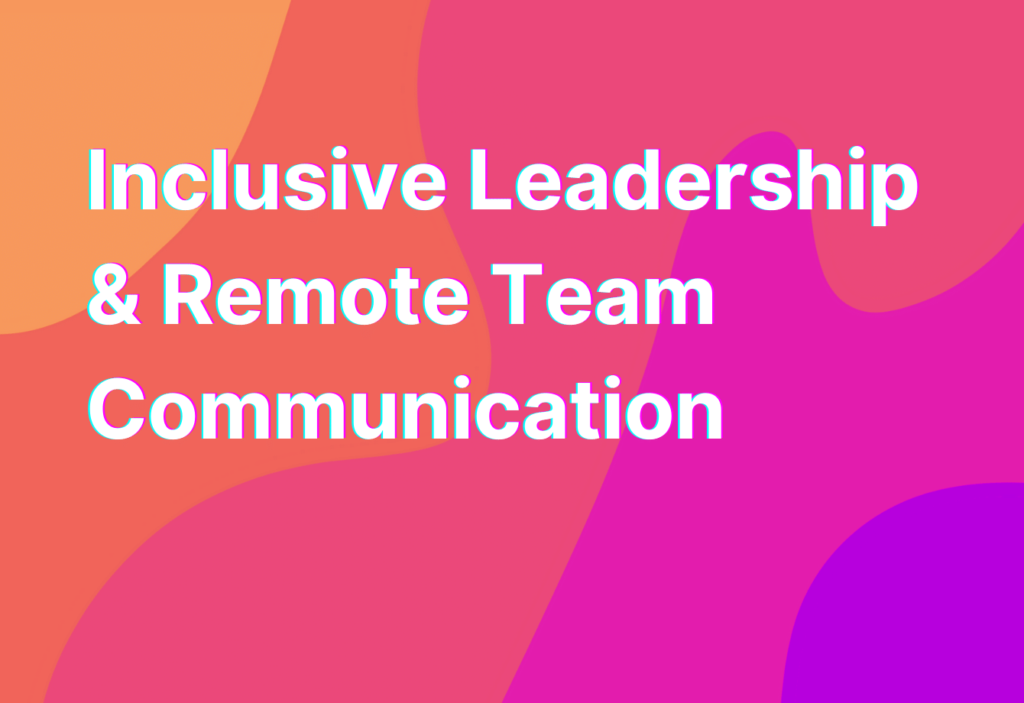Inclusive Leadership & Remote Team Communication
Welcome back, remote work enthusiasts! Today, we’re diving into the fascinating world of inclusive leadership and how it impacts remote team communication. As someone who has been working remotely for over a decade, I’ve seen firsthand the importance of inclusive leadership in fostering a positive and productive remote work environment. So, grab your favorite cup of coffee and let’s get started!
What is Inclusive Leadership?
Before we delve into the specifics of inclusive leadership in the context of remote teams, let’s first define what it means. Inclusive leadership is a leadership style that values and embraces diversity, ensuring that every team member feels valued, respected, and included. It goes beyond simply acknowledging differences; it actively seeks to create an environment where everyone’s voices are heard and valued.
Now, you might be wondering, “Ashley, why is inclusive leadership so important for remote teams?” Well, my friend, remote teams often consist of individuals from different backgrounds, cultures, and time zones. Without inclusive leadership, it’s easy for team members to feel isolated, unheard, and disconnected from the rest of the team. Inclusive leadership helps bridge these gaps and fosters a sense of belonging and collaboration.
The Benefits of Inclusive Leadership in Remote Teams
Now that we understand what inclusive leadership is, let’s explore the benefits it brings to remote teams:
- Increased creativity and innovation: When team members feel included and valued, they are more likely to share their unique perspectives and ideas. This diversity of thought leads to increased creativity and innovation within the team.
- Improved problem-solving: Inclusive leadership encourages open communication and collaboration, allowing team members to work together to find effective solutions to challenges.
- Enhanced employee engagement: When team members feel valued and included, they are more engaged and motivated to contribute their best work. This ultimately leads to higher productivity and job satisfaction.
- Reduced turnover: Inclusive leadership creates a positive work environment where team members feel supported and valued. This, in turn, reduces turnover rates and helps retain top talent.
- Stronger team cohesion: Inclusive leadership fosters a sense of belonging and camaraderie among team members, leading to stronger team cohesion and collaboration.
These are just a few of the many benefits that inclusive leadership brings to remote teams. Now, let’s explore some practical strategies for implementing inclusive leadership in your remote team communication.
Practical Strategies for Inclusive Leadership in Remote Team Communication
1. Establish clear communication guidelines: Set clear expectations for communication within your remote team. This includes guidelines for response times, preferred communication channels, and respectful communication practices.
2. Encourage active participation: Actively encourage all team members to participate in discussions and decision-making processes. Create a safe space where everyone feels comfortable sharing their thoughts and ideas.
3. Provide regular feedback and recognition: Regularly provide feedback and recognition to team members for their contributions. This helps foster a culture of appreciation and motivates team members to continue giving their best.
4. Promote diversity and inclusion: Actively seek out diverse perspectives and ensure that all team members have equal opportunities to contribute and grow. Avoid favoritism and create a level playing field for everyone.
5. Invest in team building activities: Remote teams can sometimes feel disconnected, so it’s important to invest in team building activities that foster a sense of camaraderie and connection. This can include virtual team building games, online happy hours, or even just casual check-ins.
By implementing these strategies, you can create a more inclusive and collaborative remote team communication environment. Remember, inclusive leadership is an ongoing process that requires continuous effort and commitment.
Wrapping Up
Inclusive leadership plays a crucial role in remote team communication. By embracing diversity, fostering a sense of belonging, and actively involving all team members, you can create a positive and productive remote work environment. So, let’s strive to be inclusive leaders and build stronger, more connected remote teams!
If you’re interested in learning more about remote team communication strategies, I highly recommend checking out this Job crafting article on our website. It’s packed with valuable insights and practical tips to help you enhance communication within your remote team. Happy reading!


